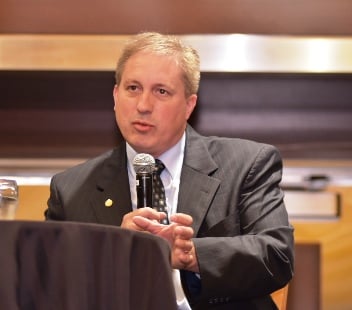Physician innovators and leaders shared their real-world payment reform experiences during a Monday education session presented by members of the AMA Innovators Committee during the 2014 AMA Annual Meeting.
Attendees got a look at how physicians can adopt care delivery reforms in their practice, including physician-led team-based care, accountable care organizations (ACO) and other new payment models.
Donald Klitgaard, MD (pictured left), explained some of the struggles he encountered as a family physician in rural Iowa and the transformation his practice underwent. Dr. Klitgaard pointed to a lack of support from payers for small practices in his state and the difficulty in getting other physicians on board when there wasn’t a clear payment stream.
Dr. Klitgaard’s practice participated for two years in a demonstration project that encouraged comprehensive care management and later formed an independent practice association with other rural practices, which was able to secure payment reform support from the payers with which they worked.
“Payers are interested in moving more risk to doctors; they just don’t have a good plan,” Dr. Klitgaard said. “It’s nice to take to them a physician-led, physician-run, organized way we can go about this and bring answers to them.”
Grace E. Terrell, MD, explained how she helped her multispecialty medical practice in North Carolina shift to a population health management hub.
“We had to do three things,” said Dr. Terrell, now president and CEO of Cornerstone Health Care in the Piedmont area of North Carolina. “We had to change the way we provided care, do some real investment in clinical and information integration, and change the way we were paid.”
Dr. Terrell discussed how the practice moved from a traditional model to a patient-centric infrastructure. Leaders began implementing different care models for different types of patients. For example, they began focusing on health failure patients in cardiology because those are the ones who are readmitted to the hospital most often. To address this, practice leaders built a care team that included psychologists, pharmacists, nurse practitioners and social workers.
At the same time, the organization moved to value-based contracts, starting with smaller payers in the local area and ultimately designing shared savings-type contracts for every payer.
“Once you [stop] worrying about fee-for-service medicine and can start thinking about the sickest patients and designing models of care around them, it can really free you up,” Dr. Terrell said.
An Innovators Committee guide (AMA login required) demonstrates how payments might flow to individual physicians, non-physician health care professionals and facilities under new delivery and payment models, focusing on fee-for-value payment models. More information, including case studies, can be found in the guide.




